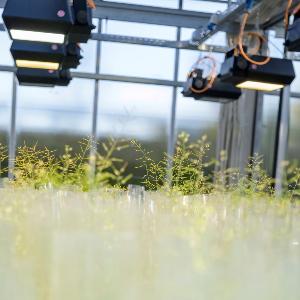Plant physiology: A tale of three proteins
25 Jun 2021
LMU biologists have shown that ‘supervisor’ and ‘motivator’ proteins are required to enable a third factor to perform its function in photosynthesis.
25 Jun 2021
LMU biologists have shown that ‘supervisor’ and ‘motivator’ proteins are required to enable a third factor to perform its function in photosynthesis.

Prof. Dario Leister in the greenhouse in Martinsried. | © LMU
Plants, algae and cyanobacteria need only three ingredients for the synthesis of sugars via the process of photosynthesis – carbon dioxide, water and sunlight. However, the operation is far more complicated than this simple list of ingredients might suggest. Prof. Dr. Dario Leister and his research group in the Department of Biology I at LMU are analyzing the complex regulation of photosynthesis. Their latest findings shed light on the roles of three proteins, named PGRL1, PGRL2 and PGR5, which participate in the control of one of the two subsystems of the photosynthetic apparatus. PGRL2 itself was first discovered in the course of the new study.
Photosynthesis involves several coordinated sequences of reactions. In the first step, a specific portion of the electromagnetic radiation emitted by the Sun is absorbed by membrane-bound pigment-protein complexes, which are organized into two ‘photosystems’ called PSI and PSII. The photosystems operate in two basic modes – linear and cyclic. In the former, PSII and PSI act in series. Light energy detaches electrons from water molecules, generating hydrogen ions (protons) and molecular oxygen. The protons are pumped to the opposite side of the membrane, while the electrons are transferred sequentially from one complex to the next, gaining in energy in the process. Ultimately, this energy is stored in the form of ATP, which drives most of the biochemical transactions in cells. Linear electron flow (LEF) through PSI also supplies the ‘reducing equivalents’ required for the conversion of carbon dioxide into sugars. The second mode of photosynthesis involves only photosystem I. Here, the electrons energized by solar radiation are diverted by other proteins, such that they follow a cyclic route. Notably, this cyclic electron flow (CEF) through PSI generates ATP only. “Plants need both subsystems,” Leister points out. The cyclic pathway is particularly significant when plants are under stress, and need more ATP. Indeed, without this mechanism plants could not survive under natural conditions.

Photosynthesis in the Arabidopsis model system. | © LMU
How is the cyclic pathway regulated? About 20 years ago, Japanese researchers set out to characterize a collection of mutants of Arabidopsis thaliana (thale cress), a popular model system used by plant geneticists. In one of these strains, a gene they called PGR5 was mutated. ‘PGR’ stands for ‘proton gradient’, and refers to the proton concentration gradient created by the transfer of protons across the membrane during the course of photosynthesis. In the mutant, formation of the gradient was perturbed. “To our surprise, the PGR5 protein had none of the sequences that one would expect to find in a typical electron transporter,” says Leister. This soon gave rise to the idea that other factors must also be involved in the maintenance of the proton gradient.
Experiments carried out by Leister in 2008 confirmed this suspicion. He discovered a second protein, which he called “pgr5-like 1” (PGRL1). Arabidopsis has two different genes that code for this factor, which explains why it did not turn up in the original mutant screen in which the PGR5 gene was identified. “At the time, we thought we had now had our hands on the really important protein,” he recalls. Inactivation of either PGRL1 or PGR5 reduces cyclic electron flow around photosystem. Furthermore, loss of PGRL1 destabilizes PGR5, but not vice versa. So it looked as if PGRL1 was a central component of the cyclic mode of photosynthesis. Moreover, this notion was supported by the fact that it contains the structural elements one would expect to find in an electron transporter.
But the regulation of cyclic electron flow later turned out to be more complex than that. Leister and his colleagues went on to identify PGRL2 as a third protein involved – and its discovery complicated matters significantly. The team showed that when PGRL2 was knocked out, photosynthesis was not affected. Conversely, overproduction of PGRL2 destabilized PGR5, even in the presence of PGRL1. The big surprise came when PGRL1 and PGRL2 were simultaneously inactivated: PGR5 reappeared and was able on its own to restore cyclic electron transport. Interestingly, these plants grew more slowly than those in which PGR5 (and cyclic electron transport) were missing. Leister offers an instructive interpretation of these findings. “PGR5 actually does the job, PGRL1 acts as a motivator of PGR5, and PGRL2 is PGR5’s supervisor. In the absence of its motivator, PGR5 is inactive. In the absence of its supervisor, it works quite well. But when motivator and supervisor are both missing, PGR5 becomes hyperactive, and ultimately destructive.
Leister’s team now plans to elucidate the biochemical mechanisms that underlie these behaviors – using cyanobacteria, which are genetically much simpler than Arabidopsis, as a model system.
Publication: T. Rühle et al: PGRL2 triggers degradation of PGR5 in the absence of PGRL1. Nature Communications, 2021.